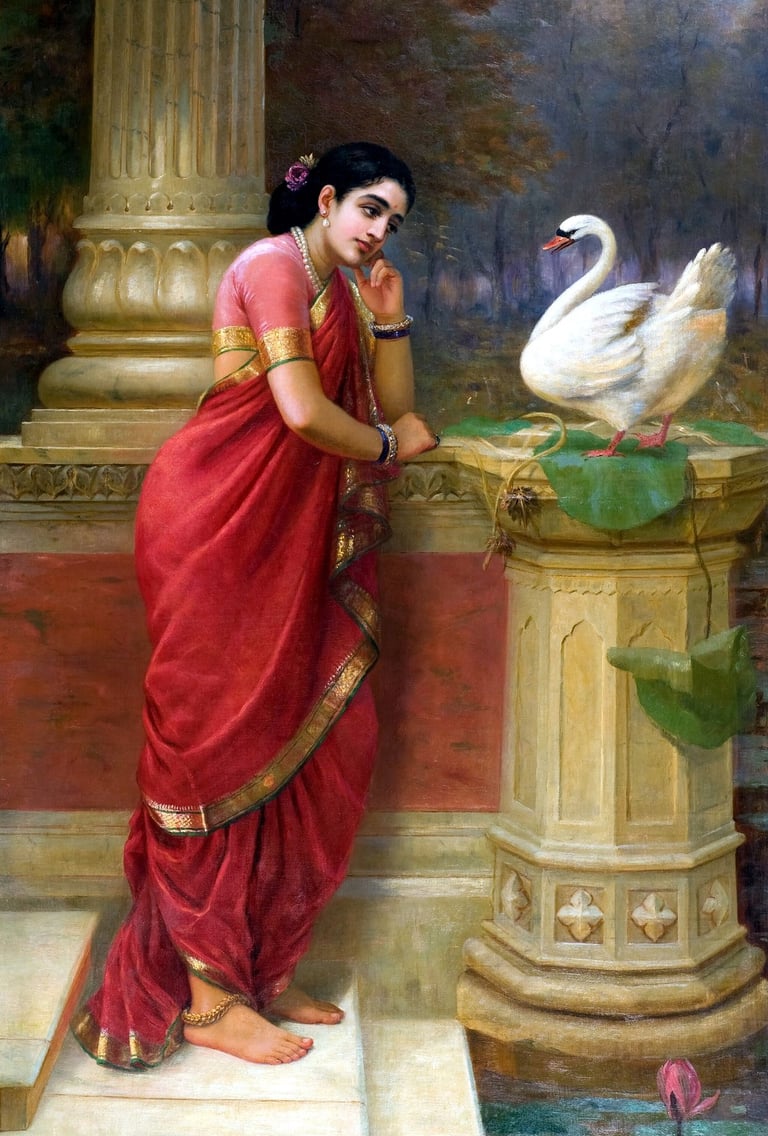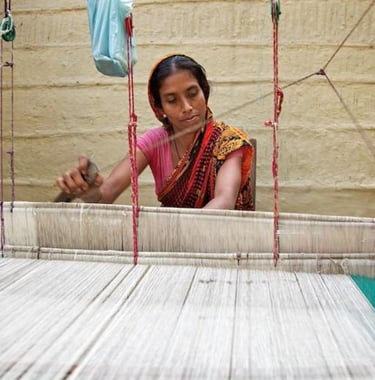House of VIJAYA
Discover a collection of exquisite ethnic sarees, thoughtfully curated to celebrate every style and occasion.


A saree for every story!
Story Highlight


Handloom Sarees: Celebrating Unique Imperfections and Timeless Tradition
Handloom sarees have long held a revered place in the fabric of cultural heritage, celebrated not just as garments but as embodiments of artisanal mastery and tradition. In today’s fast-paced world, where mass production often sidelines uniqueness, handloom sarees stand apart for their intricate craftsmanship and the subtle imperfections that narrate stories of dedication and history.
At its core, the term "handloom" refers to fabrics woven on manually operated looms. Unlike their mechanized counterparts, these looms require the steady hands and keen eyes of skilled artisans. The process is a slow, deliberate art where every thread is carefully interlaced by human hands. This meticulous craft has been passed down through generations, ensuring that each saree carries with it not only a pattern or design but also the legacy of cultural narratives and traditional techniques.
Historically, handloom weaving emerged as a primary mode of textile production in many parts of the world, with regions developing their distinct styles, motifs, and weaving techniques. In India, where sarees have been a part of everyday life and ceremonial occasions alike, the handloom industry became synonymous with quality and authenticity. Each handloom saree is a canvas reflecting local customs, vibrant colors, and a deep connection to nature and spirituality.
One of the most fascinating aspects of handloom sarees is the presence of subtle irregularities. While mass-produced fabrics strive for uniformity and flawlessness, the handloom process embraces variations that add character and authenticity to each piece. These natural irregularities are not defects but marks of individuality that set handloom sarees apart. Some common variations include:
Tears and Minor Rips:
During the weaving process, slight tears or accidental nicks can occur. However, skilled weavers often repair these with intricate patches or by seamlessly blending the repair into the design. These small imperfections serve as a reminder of the handmade process and the human touch behind every saree.Knots and Weave Variations:
Occasionally, knots form naturally in the threads during weaving. While they might seem like anomalies, these knots often contribute to the texture and depth of the fabric. They are celebrated for their uniqueness, as no two sarees will have the exact same pattern of knots or weave variations.Small Stains and Color Variations:
Natural dyes, often used in the handloom process, can result in slight color variations. These nuances in hue make each saree truly one-of-a-kind. The presence of small, unintended stains or color splotches also signifies the natural and organic processes involved in dyeing, where nature itself plays a role in creating a masterpiece.
These imperfections are a testament to the authentic, time-honored techniques that involve human labor and instinct rather than robotic precision. In many ways, they serve as a signature of the artisan’s commitment to their craft.
Handloom sarees are more than just clothing; they are cultural artifacts that embody tradition, identity, and resilience. Their significance extends across various dimensions, each highlighting the importance of preserving this ancient craft in modern times.
Every handloom saree carries with it a story—be it the legacy of a particular region, the narrative of local myths, or the tradition of a specific community. These sarees serve as a visual representation of the rich cultural heritage and artistic expression that have been nurtured over centuries. Wearing a handloom saree is akin to wearing a piece of history, and for many, it reinforces a sense of identity and pride in their cultural roots.
The handloom sector plays a crucial role in supporting rural economies and sustaining livelihoods. Many weavers and artisans rely on this craft for their daily income, and the demand for handloom sarees helps preserve traditional skills that might otherwise be lost to industrialization. Moreover, handloom production is inherently sustainable. The materials used are often natural, and the processes are low-energy compared to mechanized manufacturing, making handloom sarees an eco-friendly choice in an age where sustainability is of paramount importance.
From a fashion perspective, the aesthetic allure of handloom sarees is unmatched. The organic textures, the interplay of colors, and the nuanced details in the fabric offer a level of sophistication and individuality that is hard to replicate. Fashion enthusiasts appreciate that each handloom saree is unique—no two sarees are exactly alike. This uniqueness also opens up avenues for customization, where designers can work closely with artisans to create pieces that are tailored to personal tastes and specific occasions.
In today’s digital and fast-paced world, the preservation of traditional crafts is increasingly becoming a priority. The methods used in handloom weaving, passed down through generations, represent a treasure trove of skills and knowledge that deserve to be celebrated and continued. By supporting handloom sarees, consumers are not just purchasing a garment; they are investing in a cultural tradition that promotes art, history, and the human spirit.
Enhancing the Narrative: Beyond the Weave
While the technical aspects of handloom weaving and the charming imperfections it produces are compelling on their own, there is also a broader narrative at play—one that connects the consumer to a larger story of art, culture, and sustainability.
Handloom sarees are a canvas for artistic expression. The motifs, patterns, and techniques vary widely from region to region, reflecting local stories, nature, and mythology. This integration of art and craft means that each saree is more than just a piece of fabric; it is a work of art that carries the imprint of an artisan’s creativity.
For instance, traditional sarees from regions like Kanchipuram, Banaras, or Assam each have distinctive features that tell a unique story. The intricacies of the zari work in Kanchipuram sarees or the vibrant colors and textures of Assamese silk are celebrated not only for their beauty but also for the skills and dedication required to produce them.
In a world that often equates perfection with value, handloom sarees challenge conventional norms by embracing the beauty of imperfection. These subtle irregularities remind us that beauty lies in authenticity and that the human touch can create art that is both unique and profound. The philosophy behind this is rooted in the belief that true craftsmanship is not about creating flawless objects but about celebrating the process and the individuality of each creation.
In conclusion, handloom sarees represent much more than a mode of dressing; they are living embodiments of culture, tradition, and artistic expression. Their unique appeal lies in the combination of masterful handcrafting, natural imperfections, and the rich heritage that they carry forward. Each saree is a testament to the legacy of countless artisans who have dedicated their lives to perfecting this craft, and each imperfection is a badge of honor—a reminder of the human touch behind every thread. For those who choose to wear a handloom saree, the experience goes beyond mere aesthetics. It is a conscious choice to support sustainable practices, preserve traditional crafts, and celebrate the beauty of imperfection. As the world continues to evolve and modernity pushes the boundaries of production, the timeless charm of handloom sarees serves as a gentle reminder of the value of tradition, authenticity, and the artistry that defines human culture.
Handloom sarees are not just garments; they are stories woven into fabric. They remind us that beauty often lies in the details and that every imperfect weave is a mark of genuine craftsmanship. Whether you are a connoisseur of traditional fashion or someone looking to embrace sustainable style, the handloom saree offers an unparalleled experience—a blend of history, art, and the enduring spirit of tradition.
By exploring what handloom truly means, acknowledging the beauty in its imperfections, and understanding its cultural significance, we can appreciate handloom sarees as timeless treasures that enrich our lives and our wardrobe. Every handloom saree is a unique piece of art, a fragment of history, and a celebration of the human spirit woven together in every thread.


